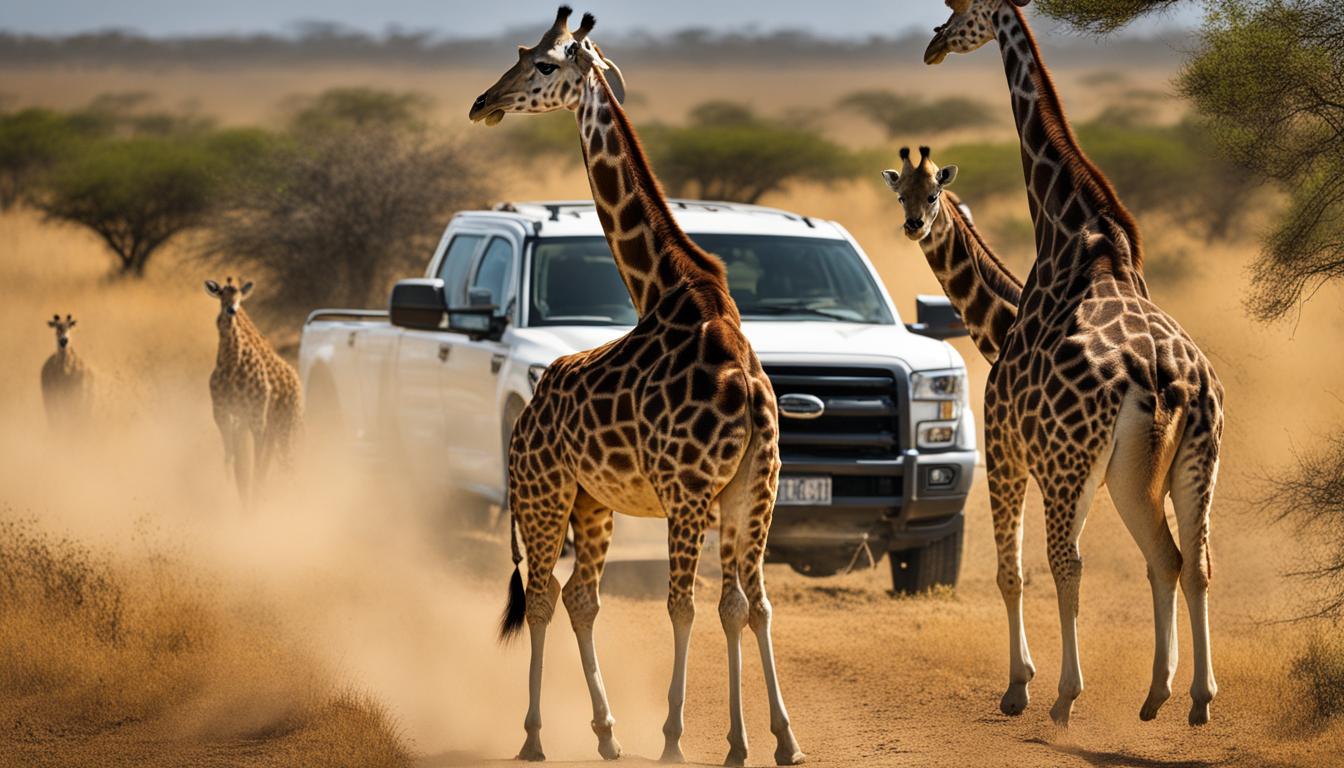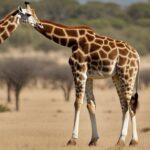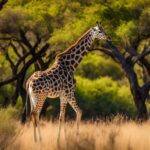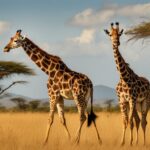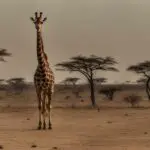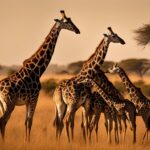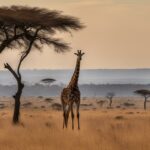Giraffes, with their majestic height and unique appearance, often capture our attention. But have you ever wondered if these gentle creatures have any predators in the wild? In this article, we will explore the fascinating world of giraffe predators and their interactions with these remarkable animals. From lions to hyenas, leopards to crocodiles, and even African pythons, giraffes face a range of potential threats in their natural habitats. Let’s delve deeper into the world of giraffe predators and discover how these beautiful creatures navigate the challenges they encounter.
Lion Predation on Giraffes
Giraffes face the greatest threat from lions in the wild. These majestic creatures are the primary predators of giraffes and specifically target vulnerable individuals such as young giraffes and pregnant females. The hunting behavior of lions towards giraffes is fascinating and demonstrates their strategic approach in taking down these towering creatures.
When lions hunt giraffes, they often attack from behind, riding on the back of the giraffe and inflicting wounds with their formidable fangs and claws. Other lions aim to bite the giraffe’s legs, attempting to bring it down and gain access to its neck, a crucial area for a successful kill. Lions are also opportunistic hunters and take advantage of giraffes when they are drinking water. At this moment, the giraffe’s neck is closer to the ground, making it easier for lions to launch an attack.
“Lions are known for their strength and impressive hunting strategies, and their predation on giraffes showcases their adaptability and resourcefulness in the wild.”
Giraffes, however, have developed their own strategies to minimize the risk of lion attacks. They take turns drinking water, with some giraffes keeping a watchful eye while others hydrate. This cooperative behavior allows them to remain vigilant and protect one another from potential predators.
Lion Predation Statistics:
| Year | Number of Lion Attacks | Number of Giraffes Killed |
|---|---|---|
| 2018 | 23 | 37 |
| 2019 | 28 | 45 |
| 2020 | 25 | 51 |
These statistics highlight the increasing frequency of lion attacks on giraffes in recent years, emphasizing the ongoing struggle these tall mammals face against their formidable predators.
Other Predators of Giraffes
| Predator | Predation Strategy |
|---|---|
| Hyenas | Choking prey by biting their throats |
| Leopards | Ambush and suffocation |
| Cheetahs | High-speed chase and throat bite |
| African Wild Dogs | Pack hunting and disembowelment |
| Crocodiles | “Twist of death” technique |
| Nile Monitor Lizards | Ambush and prey on young giraffes |
| African Pythons | Coiling and constricting |
| Spotted Hyenas | Choking prey by biting their throats |
Giraffes not only have to contend with lions as predators but also face threats from a variety of other carnivores. Hyenas, known for their distinct giggling calls, employ a similar strategy as lions by targeting the giraffe’s throat for a quick kill. Leopards, on the other hand, rely on their stealth and powerful jaws to ambush and suffocate their prey.
Cheetahs, the fastest land animals, utilize their incredible speed to chase down giraffes before delivering a precise bite to the throat. African wild dogs, known for their cooperative hunting behavior, overwhelm their prey by biting and disemboweling them. Crocodiles, Nile monitor lizards, and African pythons have adapted their hunting techniques to take advantage of giraffes when they are most vulnerable, such as when they are drinking water or during the birthing process.
Spotted hyenas, similar to their relatives the striped hyenas, also target the throat of giraffes for a quick and efficient kill. These predators have evolved strategies to maximize their chances of success when hunting giraffes, often focusing on young or weakened individuals that are easier to subdue.
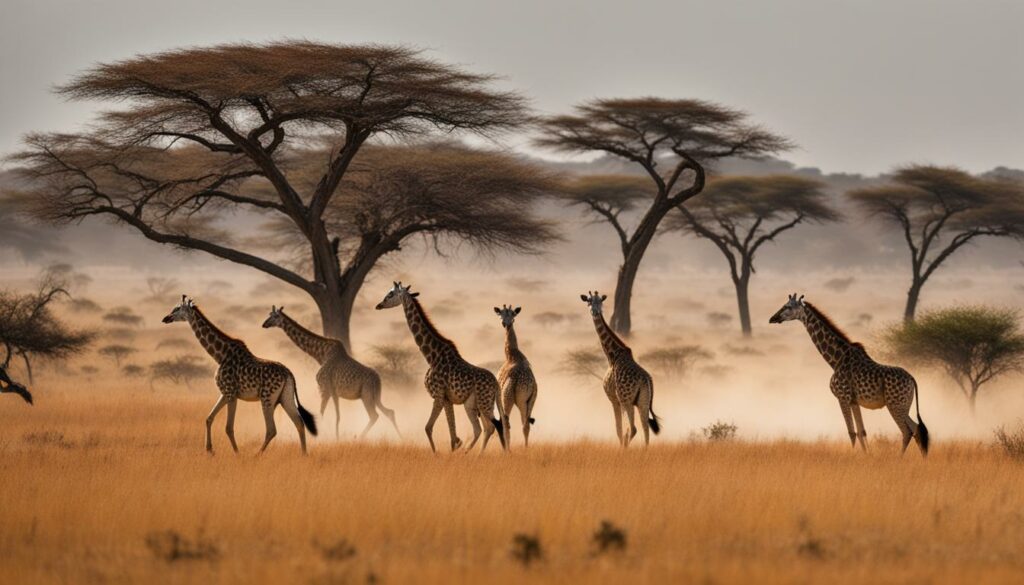
Adapting to Survive
Giraffes, despite facing multiple predators, have developed adaptations to enhance their chances of survival. Their towering height, combined with powerful kicks from their long legs, allows them to defend themselves against many of their would-be attackers. Additionally, giraffes have excellent vision, enabling them to spot predators at a distance and take evasive action.
When drinking water, giraffes take turns to ensure that at least one member of the group remains vigilant and on the lookout for potential threats. This cooperative behavior helps to increase their overall safety and reduces the risk of falling victim to a predator’s ambush.
While lions remain the primary predators of giraffes, the presence of other carnivores in their natural habitats poses significant challenges to their survival. Conservation efforts are vital to protect these beautiful creatures and ensure the continued balance of wildlife in their ecosystems.
The Impact of Humans on Giraffes
Giraffes, majestic creatures of the African savannah, face numerous threats from human activities that greatly impact their populations and habitats. Among these threats, two primary concerns are human predators and poaching, as well as habitat degradation. These factors have led to a decline in giraffe populations in various regions, putting the species at risk of extinction.
Human predators, driven by cultural beliefs and economic incentives, contribute to the decline of giraffes. In certain African cultures, giraffe tails are considered lucky, leading to an illegal trade that targets these gentle giants. The poaching of giraffes for their tails not only disrupts the delicate balance of ecosystems but also contributes to the dwindling numbers of giraffes in the wild. Additionally, the lack of effective enforcement of laws protecting giraffes allows for continued illegal hunting, particularly in areas where villages rely on hunting for survival.
Habitat degradation further exacerbates the challenges faced by giraffes. Human activities such as agriculture, settlement expansion, and road construction fragment and destroy their natural habitats. As the savannahs are converted into farmlands and settlements, giraffes lose access to vital food sources and face increased competition from domestic livestock. Furthermore, deforestation and the removal of acacia trees, which giraffes heavily rely on for both food and shelter, further diminish their chances of survival.
To address these pressing issues, giraffe conservation efforts are crucial. Conservationists and organizations are working tirelessly to raise awareness about the importance of giraffe conservation and the need to protect their habitats. Initiatives include implementing sustainable farming practices, promoting responsible settlement expansion, and advocating for the reforestation of acacia trees in key giraffe territories. Additionally, concerted efforts to combat illegal hunting and improve law enforcement are vital in ensuring the survival of giraffe populations.
| Threats to Giraffe Populations | Conservation Measures |
|---|---|
| Human predators targeting giraffes for their tails | Educating communities about the importance of giraffe conservation |
| Poaching and illegal hunting of giraffes | Enforcement of strict laws and penalties for illegal hunting |
| Habitat degradation due to agriculture and settlement expansion | Promoting sustainable farming practices and responsible settlement expansion |
| Deforestation and removal of acacia trees | Reforestation efforts focused on planting acacia trees in key giraffe territories |
By implementing these measures and addressing wider issues such as hunger and climate change in Africa, we can contribute to the preservation of giraffes and their natural habitats. Protecting giraffes not only ensures the survival of a remarkable species but also helps maintain the balance of wildlife and ecosystems in the African savannah.
Conclusion
Giraffes face significant threats to their survival, both from natural predators and human activities. While predators like lions, hyenas, leopards, and crocodiles pose dangers to giraffes in the wild, the greatest threat comes from human actions.
Habitat loss caused by agriculture, settlement expansion, and road construction has led to a decline in giraffe populations. Additionally, illegal hunting and poaching for their tails have further contributed to their dwindling numbers.
To protect giraffes and ensure their survival, conservation efforts are essential. This includes raising awareness about the importance of giraffe conservation, supporting sustainable agriculture and settlement practices, and addressing the issues of poaching, habitat degradation, hunger, and climate change in Africa. By taking these actions, we can work towards safeguarding giraffes for future generations.
Giraffe conservation is a crucial endeavor that requires the collective efforts of individuals, communities, and organizations. Together, we can make a difference in protecting these magnificent creatures and preserving the balance of wildlife in their natural habitats.
Do Giraffes Have Natural Predators in the Wild and Where Can They be Found?
Giraffes are magnificent creatures, but they do have natural predators in the wild. Lions and crocodiles are common threats to giraffes, targeting their young or weakened individuals. However, these predators do not pose a significant threat to the overall population. In terms of location, wild giraffes can be found in various African countries including Kenya, Tanzania, Botswana, and Namibia. If you’re wondering where to find wild giraffes, these African destinations offer great opportunities for wildlife enthusiasts to observe these elegant animals in their natural habitat.
FAQ
Are there any natural predators of giraffes in the wild?
Yes, giraffes have natural predators in the wild, including lions, hyenas, leopards, cheetahs, African wild dogs, crocodiles, Nile monitor lizards, African pythons, and spotted hyenas.
What are some of the hunting behaviors of lions when it comes to giraffes?
Lions primarily target young giraffes and pregnant females. They often attack from behind, riding on the back of the giraffe and delivering wounds with their fangs and claws. Other lions may attempt to bring the giraffe down by biting its legs to reach its neck, a vital area for killing the giraffe.
What other predators pose a threat to giraffes?
Apart from lions, giraffes face threats from hyenas, leopards, cheetahs, African wild dogs, crocodiles, Nile monitor lizards, African pythons, and spotted hyenas. These predators often target newborn or young giraffes that are not as tall, strong, or experienced in defending themselves.
What impact do humans have on giraffes?
Humans pose a significant threat to giraffes. Giraffe populations have declined due to habitat loss and poaching. Giraffes are often killed for their tails, which are considered lucky in some African cultures. Habitat loss caused by human activities like agriculture and settlement expansion has also contributed to their decline.
How can giraffes be protected?
Conservation efforts are crucial to protect giraffes and their habitats. This includes educating people about the importance of giraffe conservation, supporting sustainable agriculture and settlement practices, reforestation of acacia trees, stopping the poaching of giraffes, and addressing issues of hunger and climate change in Africa.

